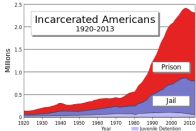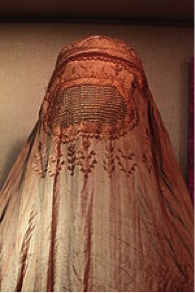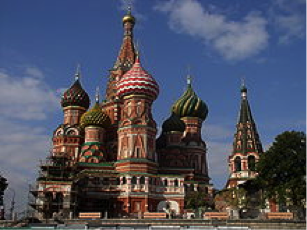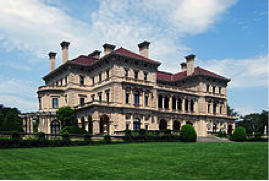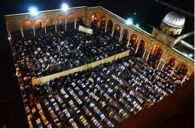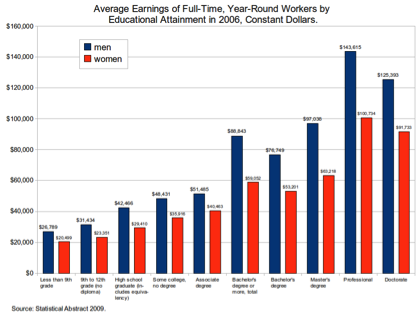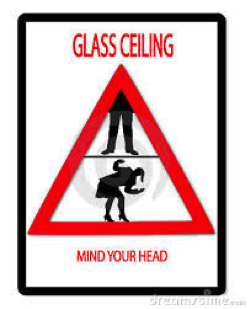Walls Separating People
A look at how walls have been used to continue institutionalized oppression and elite-sanctioned "othering."
Prisons: Walls Around People
The use of walls to confine people, commonly called prisons or jail, has a long and evolving history. People in prison are denied certain freedoms or liberties as defined by the state. The US currently has the world's largest prison population of over 2 million, or about 1% of the population, and the world's highest per capita incarceration rate.
The design of prisons and the walls that confine the individual prisoners as well as the prison community evolved with time and philosophy. Even after being freed from the physical prison walls, there remain barriers to the integration back into society and securing employment.
In total the US has approximately 7 million adults, or about 3% of adults, under some form of correctional supervision. A range of barriers and restrictions, such as to voting and employment, confronts many of these people. It is estimated that the US spends $74 billion on confinement and correction issues. There is also a well documented racial bias, with a higher percentage of people of color subjected to incarceration. (Wikipedia: Prison; Incarceration in the United States)
Women and Walls
Men, due to a need for domination or to superstition, have attempted to sexually wall off women. This begins with an excessive focus on the female hymen, an anatomical structure found in many mammals that seems to present as a barrier to the vagina. Historically, males have used the presence of the hymen as a test of purity; an intact hymen is seen as confirmation of a lack of sexual activity by the female.
An extension of this obsession with controlling of female sexuality is female genital mutilation (FGM) or female genital cutting. This procedure comes in various forms and may involve removal of part of the clitoris, removal of the inner labia and outer labia, and closure of the vulva. The vagina is walled off when the wound is stitched together, leaving a small hole to allow urine and menstrual fluid to pass. This wall protects a woman’s virginity until marriage, when the male attempts to penetrate the female. FGM causes many complications depending on the severity of the procedure, including a lifetime of pain and pleasure denied, or even death. Ultimately this procedure is unethical, as it does not respect the autonomy of the individual. FGM is primarily performed in Africa, with an estimated 130 million women in 29 countries affected.
- Hymen – Wikipedia - https://en.wikipedia.org/wiki/Hymen
- Virginity – Wikipedia - https://en.wikipedia.org/wiki/Virginity
- Female genital mutilation – Wikipedia - https://en.wikipedia.org/wiki/Female_genital_mutilation
Clothes as Walls
Many religious traditions encourage women to dress modestly and wear a head veil; these symbolize submission to the male. Many religions encourage women to dress modestly in order not to attract the attention of other males. The specific rules of dress and head coverings, and the requirements to cover the genitals and the breasts, vary within and between different religions, depending the interpretation of religious texts.
In general the more conservative branches of the religion have greater restrictions on clothing, for the women in particular. This can be seen as the males demanding a wall between the women and the outside world, with women often seen as personal property. It is rooted in men's fear of the women leaving, or of other males imposing themselves. It can also be interpreted as the males' sex drive being easily aroused and uncontrollable, with the responsibility for control passed to the females.
Religious habit – Wikipedia - https://en.wikipedia.org/wiki/Religious_habit
Jewish tzniut – Wikipedia - https://en.wikipedia.org/wiki/Tzniut
Christian headcovering – Wikipedia - https://en.wikipedia.org/wiki/Christian_headcovering
Hijab or veil – Wikipeida - https://en.wikipedia.org/wiki/Hijab
Niqab – Wilipedia - https://en.wikipedia.org/wiki/Niqāb
Awrah – Wikipedia - https://en.wikipedia.org/wiki/Intimate_parts_in_Islam
Burqa – Wikipedia - https://en.wikipedia.org/wiki/Burqa
Walls Demonstrating Power and Wealth
People and institutions often build elaborate buildings with elaborate walls to demonstrate power and wealth. Castles and churches are classic examples of the demonstration of the power of wealth. Castles were first built in the Middle Ages, in the ninth and tenth centuries, by the nobility as fortified structures to defend the surrounding area; they also contained the nobles' residences and administrative headquarters. England's Windsor Castle, started in the 11th century, is one of the greatest examples of a castle that has a long history of occupation and expansion over the ages. Castles typically had elaborate and thick walls, with towers and exquisite interior rooms.
Churches of that era, and even now, can be large opulent structures. The Christian church is often constructed on the shape of a cross, with a long entry way and high cellings. The largest churches took decades to build and were a centerpoint of the communities they were in. They exuded power and wealth, with high walls that have stood for centuries.
Mansions, large homes of wealthy people, have been built for millennia. Modern mansions contain luxurious surroundings, swimming pools, gyms, theaters, libraries, and other amenities. Mansions may contain extensive art collections and owners are typically very private and have elaborate security systems. Like other large dwellings, mansions provide the users with privacy and security.
- Castles – Wikipedia - https://en.wikipedia.org/wiki/Castle
- Windsor Castle – Wikipedia - https://en.wikipedia.org/wiki/Windsor_Castle
- Church (building) - https://en.wikipedia.org/wiki/Church_(building)
- Architecture of cathedrals and great churches - https://en.wikipedia.org/wiki/Architecture_of_cathedrals_and_great_churches
Walls That Separate the Races: Racism and Walls
Racism conjures up images of a variety of walls purposely designed to keep people separate based on skin color, religion, or other differences. In the US Jim Crow Laws mandated that people of color use other facilities or sit in the back of shared spaces. Voting was restricted by bizarre means and questions. The white government kept blacks from owning the walls of their own homes, restricted federal loans, and even erected physical walls (see Detroit Wall, below).
Seattle.gov redlining - http://www.seattle.gov/cityarchives/exhibits-and-education/seattle-voices/redlining
In 1976, Seattle City Council took a stand against redlining, a discriminatory practice targeted at African-Americans and others of color, by which banks, insurance companies, and other institutions, refused or limited loans, mortgages, and insurance within specific geographic areas. Redlining also included the practice of banks not reinvesting funds they received from low income neighborhoods back into those communities. A six-month study by the Central Seattle Community Council Federation released in July 1975, "Redlining and Disinvestment in Central Seattle," examined 1,150 property transactions in Seattle. The study found that eight major banking institutions did not make more than two loans each in the Central Area and Rainier Valley from 1970 to 1974. Prompted by this report, the Mayor established a Reinvestment Task Force to propose policies to eliminate redlining, or disinvestment, as it was also called.
Redlining – Wikipedia - https://en.wikipedia.org/wiki/Redlining
In the United States, redlining is the practice of denying services, either directly or through selectively raising prices, to residents of certain areas based on the racial or ethnic makeups of those areas. While some of the most famous examples of redlining regard denying financial services such as banking or insurance, other services such as health care or even supermarkets, can be denied to residents to carry out redlining.
Detroit Wall – Wikipedia - https://en.wikipedia.org/wiki/Detroit_Wall
The Detroit Eight Mile Wall, also referred to as Detroit's Wailing Wall, Berlin Wall or The Birwood Wall; is a 1 foot (0.30 m) thick, 6 feet (1.8 m) high wall that stretches about .5 miles (0.80 km) in length. It is a wall of racial separation erected in 1940 as a physical barrier between white and black homeowners in northwest Detroit.
The five walls of racism – blog by Abagond – May 26, 2010 -- https://abagond.wordpress.com/2010/05/26/can-white-americans-be-unracist/
Walls to Separate the Sexes
The have been a wide range of reasons to separate people by their sex. This practice is visible in the military, educational institutions, places of worship, and the world of competitive sports. Some of this separation is for very practical reasons and some due more to habit and sense control. The separation of the sexes reinforced the glass ceiling (see above) by creating an atmosphere of unequal access to information.
Seating in churches can be arranged to separate people by their sex. The catholic Canon 1262, § 1. states “It is desirable that, in harmony with ancient Church order, the women in church be separated from the men.” Similarly, in traditional Jewish synagogues, men and women sit separately at gatherings. Some interpretations of Islam in Muslim countries and communities require the separation of men and boys from women and girls in social settings.
The severe walling off of men and women has been referred to as "gender apartheid." The walls between men and women have severe economic, educational, and social consequences. The rules and restrictions on females are often institutionalized through religious and cultural practices that result in the boys and men feeling they must guard a woman’s purity and chastity. The consequence of the walls between males and females is that women are disempowered and men disrespect women, seeing them as property.
- Sex segregation - Wikipedia - https://en.wikipedia.org/wiki/Sex_segregation
- Gender segregation and Muslims – Wikipedia - https://en.wikipedia.org/wiki/Gender_segregation_and_Muslims
- Gender apartheid – Wikipedia - https://en.wikipedia.org/wiki/Gender_apartheid
The Glass Ceiling as a Wall
A glass ceiling is a metaphorical wall that keeps women and minorities from reaching their potential in the workplace. The term was first used in 1979 to refer to qualified women who were not being promoted despite corporate policy and individual qualifications. It was commonly used in the 1980s to refer to an invisible barrier that kept minorities, primarily women, from advancing professionally. The term “stained-glass ceiling” has been used to highlight how difficult it is for women to assume higher-level positions in religious communities.
A more subtle form of the glass ceiling is the pay gap between men and women. The subtle and not-so-subtle walls in places of employment create a cascade of inequities, with some people receiving less money for the same work. The glass ceiling has become a powerful symbol of societal inequities.
Glass ceiling - Wikipedia - https://en.wikipedia.org/wiki/Glass_ceiling
Stained-glass ceiling – Wikipedia - https://en.wikipedia.org/wiki/Stained-glass_ceiling
Voter Suppression: Walls That Block Voting
Voter suppression is a strategy to influence the outcome of an election by discouraging or preventing people from exercising the right to vote. (Wikipedia, voter suppression) Voter suppression involves a wide range of techniques to create walls that outright block access to voting booths. Jim Crow laws represent the extreme nature of efforts to erect very high walls around voting, which did not end until the passage of the Voting Rights Act of 1965. Currently there are many more subtle methods such as requiring official photo ID, felon disenfranchisement, voter role manipulation, and restrictions on the number or opening of polling stations.
Voter suppression – Wikipeida - https://en.wikipedia.org/wiki/Voter_suppression - https://en.wikipedia.org/wiki/Voter_suppression_in_the_United_States
Book – “The New Jim Crow” – Michelle Alexander - http://newjimcrow.com - https://en.wikipedia.org/wiki/The_New_Jim_Crow
header photo: Photo by Baher Khairy on Unsplash


